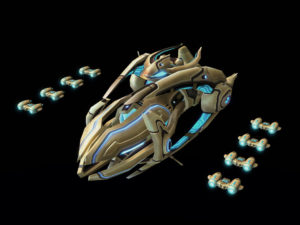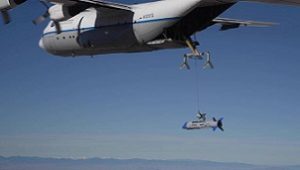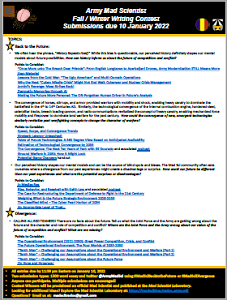[Editor’s Note: Last month, the Defense Advanced Research Projects Agency (DARPA) carried out a successful flight test of a C-130 Hercules transport aircraft deploying several drones, and more importantly, successfully recovering one while in flight. In today’s post, returning guest blogger and proclaimed Mad Scientist Zak Kallenborn explores what the advent of drone motherships portends for the future battlefield and examines the potential ramifications they have for multi-domain drone swarm operations — Read on!]

When I was young, around 16 or so, I loved the video game StarCraft. For those unfamiliar, StarCraft is a real-time strategy game where futuristic armies battle for territorial supremacy. My favorite unit was always the Protoss Carrier — a 25th century dirigible-looking aircraft that spits out four little robot planes (eight if you have the upgrade). I loved to build like ten Carriers and watch all the pixelated drones swarm all over the battlefield and destroy everything in sight. The tough part was I built my whole strategy around the Carrier; as soon as they were destroyed, so was I.
The imaginary Protoss Carrier illustrates important lessons around using drone swarms in a real 21st century battlefield. Particularly, the Protoss Carrier shows the importance of mothership-like concepts to support drone swarm deployment, rearmament, and repair. The challenge for the United States and other militaries is how best to defend the mothership and integrate it with other weapons platforms.
The Mothership Concept

A drone swarm mothership is an unmanned or manned system that transports the swarm to the battlefield. If a military wishes to bring thousands or even millions of drones to the battlefield, a mothership is almost certainly necessary. So many drones take up a lot of space. Millions of drones cannot fit in the bay of an F-35 or even the hold of a destroyer (unless they are super small.) Each drone may need to be refueled, repaired, and rearmed. Where will they recharge? Who will repair them? How?
A mothership can serve all of those functions. A mothership is a single platform to provide transport and other services to maintain the drone swarm. For example, the French ECA Group built a ship that deploys and supports various surface and subsurface vehicles for mine counter-measure operations (the vehicles do not form true swarms, but they could). Motherships may also be networked together to enable coordination between the drones to ensure drones from one carrier do not interfere with the operations of another. In the near-term, a mothership is likely to be manned, at least minimally, with humans carrying out basic maintenance tasks.
Protecting the Mothership

In evaluating threats and friendly applications for increasingly large drone swarms, the military must consider how best to protect and target motherships. For all the advantages motherships provide in deploying and using swarms, they are also an obvious point of failure. If the mothership is destroyed, all the drones it contains and supports will be destroyed too. A drone swarm mothership operating on land, in the air, at sea, under the sea, or in space presents essentially the same challenge as an aircraft carrier at lower scale: how do you protect a big, valuable platform?
Drone motherships must necessarily be significantly larger than the component drones to carry all of them. And likely, the mothership must be significantly larger to support transportation, energy generation, and any other capabilities. Thus, protecting the mothership is functionally equivalent to protecting any large platform. The mothership may have stealth capabilities, such as camouflage or reduced radar profiles. Stealth details would naturally depend on the domain of operation: desert camouflage patterns are obviously not useful for an aerial mothership. As with an  aircraft carrier battle group, the mothership might also be incorporated into larger groups of manned and unmanned systems that can provide support, such as air and missile defenses.
aircraft carrier battle group, the mothership might also be incorporated into larger groups of manned and unmanned systems that can provide support, such as air and missile defenses.
An important question is whether the mothership can or should deploy drones capable of countering potential threats. This will depend on the type of drones, their payloads, and how quickly they can be deployed and used. A ground-based mothership may worry about tanks, and so may incorporate anti-tank drones within the swarm. Drone swarms can, and already do, operate across multiple domains, which complexifies the challenge. A drone swarm operating in multiple domains would need to worry about potential threats across the full range of the swarm’s operations.
Regardless of concept, electronic and cyber-attack are likely to be key vulnerabilities. Motherships must have some way of communicating with the drones under its command. At the bare minimum, the mothership must emit some form of signal — passive or active — so the drones within the swarm know where to return to. An adversary may seek to disrupt the signal or provide fake signals to separate the swarm from the carrier. Likewise, any autonomous or other control systems within the mothership may be disabled, manipulated, or otherwise corrupted.

Policy Recommendations
To the degree that drone swarms are important parts of the future battlefield, mothership concepts are likely to become increasingly prevalent to manage the complexity. The United States military should explore different concepts of motherships, varying both the nature of the platform and the type of drones included. This should especially emphasize exploring differing combinations of manned vs. unmanned systems and how motherships may support existing systems. In addition, the military should include electronic and cyber defense as a critical aspect of mothership research and development and acquisition. The military should also think critically about the best approaches to defeat adversary motherships, including electronic and cyber attack. This does not need to be fancy: a simple anti-vehicle mine may be deadly against even the most sophisticated ground-based mothership.
If you enjoyed this post, check out Zak Kallenborn‘s previous Mad Scientist Laboratory blog posts:
How Big of a Deal are Drone Swarms?
A New Age of Terror: The Future of CBRN Terrorism
A New Age of Terror: New Mass Casualty Terrorism Threats
… and explore how drones and drone swarms could be employed across all domains on the future battlefield in the following posts:
Insights from the Robotics and Autonomy Series of Virtual Events post and the associated webinar content (presenter biographies, slide decks, and notes) and videos
Ground Warfare in 2050: How It Might Look and “The Convergence” — Episode 6: The Intelligent Battlefield of the Future and podcast, featuring proclaimed Mad Scientist Dr. Alexander Kott
Jomini’s Revenge: Mass Strikes Back! by proclaimed Mad Scientist Zachery Tyson Brown
“Own the Night” and the associated Modern War Institute podcast with proclaimed Mad Scientist Mr. Bob Work
Top Attack: Lessons Learned from the Second Nagorno-Karabakh War and associated podcast
Insights from the Nagorno-Karabakh Conflict in 2020 and Insights from the Nagorno-Karabakh Conflict in 2020 (Part II)
“Once More unto The Breach Dear Friends”: From English Longbows to Azerbaijani Drones, Army Modernization STILL Means More than Materiel, by Ian Sullivan
Major Trends in Russian Military Unmanned Systems Development for the Next Decade, Autonomous Robotic Systems in the Russian Ground Forces, and Russian Ground Battlefield Robots: A Candid Evaluation and Ways Forward, by proclaimed Mad Scientist Sam Bendett
The PLA and UAVs – Automating the Battlefield and Enhancing Training
A Chinese Perspective on Future Urban Unmanned Operations
China: “New Concepts” in Unmanned Combat and Cyber and Electronic Warfare
The PLA: Close Combat in the Information Age and the “Blade of Victory”
Creating a Convergence of Technologies to Defeat the Deadly Fast Inshore Attack Craft Threat Before 2050, by proclaimed Mad Scientist CAPT George Galdorisi, (U.S. Navy–Ret.)
The Democratization of Dual Use Technology
Star Wars 2050, by proclaimed Mad Scientist Marie Murphy
>>>> REMINDER: Army Mad Scientist Fall / Winter Writing Contest: Crowdsourcing is an effective tool  for harvesting ideas, thoughts, and concepts from a wide variety of interested individuals, helping to diversify thought and challenge conventional assumptions. Army Mad Scientist seeks to crowdsource the intellect of the Nation (You!) with our Fall / Winter Writing Contest’s two themes — Back to the Future and Divergence – check out the associated writing prompts in the contest flyer and announcement, then get busy crafting your submissions — entries will be accepted in two formats:
for harvesting ideas, thoughts, and concepts from a wide variety of interested individuals, helping to diversify thought and challenge conventional assumptions. Army Mad Scientist seeks to crowdsource the intellect of the Nation (You!) with our Fall / Winter Writing Contest’s two themes — Back to the Future and Divergence – check out the associated writing prompts in the contest flyer and announcement, then get busy crafting your submissions — entries will be accepted in two formats:
Written essay (no more than 1500 words, please!)
Tweet @ArmyMadSci, using either #MadSciBacktotheFuture or #MadSciDivergence
We will pick a winner from each of these two formats!
 Contest Winners will be proclaimed official Mad Scientists and be featured in the Mad Scientist Laboratory. Semi-finalists of merit will also be published!
Contest Winners will be proclaimed official Mad Scientists and be featured in the Mad Scientist Laboratory. Semi-finalists of merit will also be published!
DEADLINE: All entries are due NLT 11:59 pm Eastern on January 10, 2022!
Any questions? Don’t hesitate to reach out to us — send us an eMail at: madscitradoc@gmail.com
Zachary Kallenborn is a national / homeland security consultant with expertise in unmanned systems, weapons of mass destruction (WMD), and WMD terrorism. His work has been published in Studies in Conflict and Terrorism, the Nonproliferation Review, War on the Rocks, the Modern War Institute at West Point, DefenseOne, and various other outlets. His research has been written about in Forbes, Popular Mechanics, Homeland Security Today, the National Interest, and Yahoo News. His most recent study examines whether drone swarms could be considered weapons of mass destruction.
Disclaimer: The views expressed in this blog post do not necessarily reflect those of the Department of Defense, Department of the Army, Army Cyber Institute, the U.S. Military Academy, Army Futures Command (AFC), or U.S. Army Training and Doctrine Command (TRADOC).



